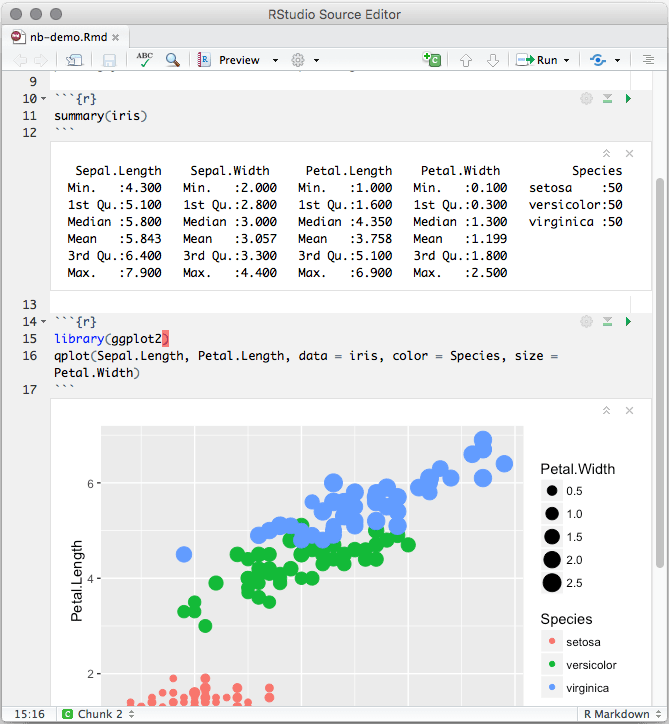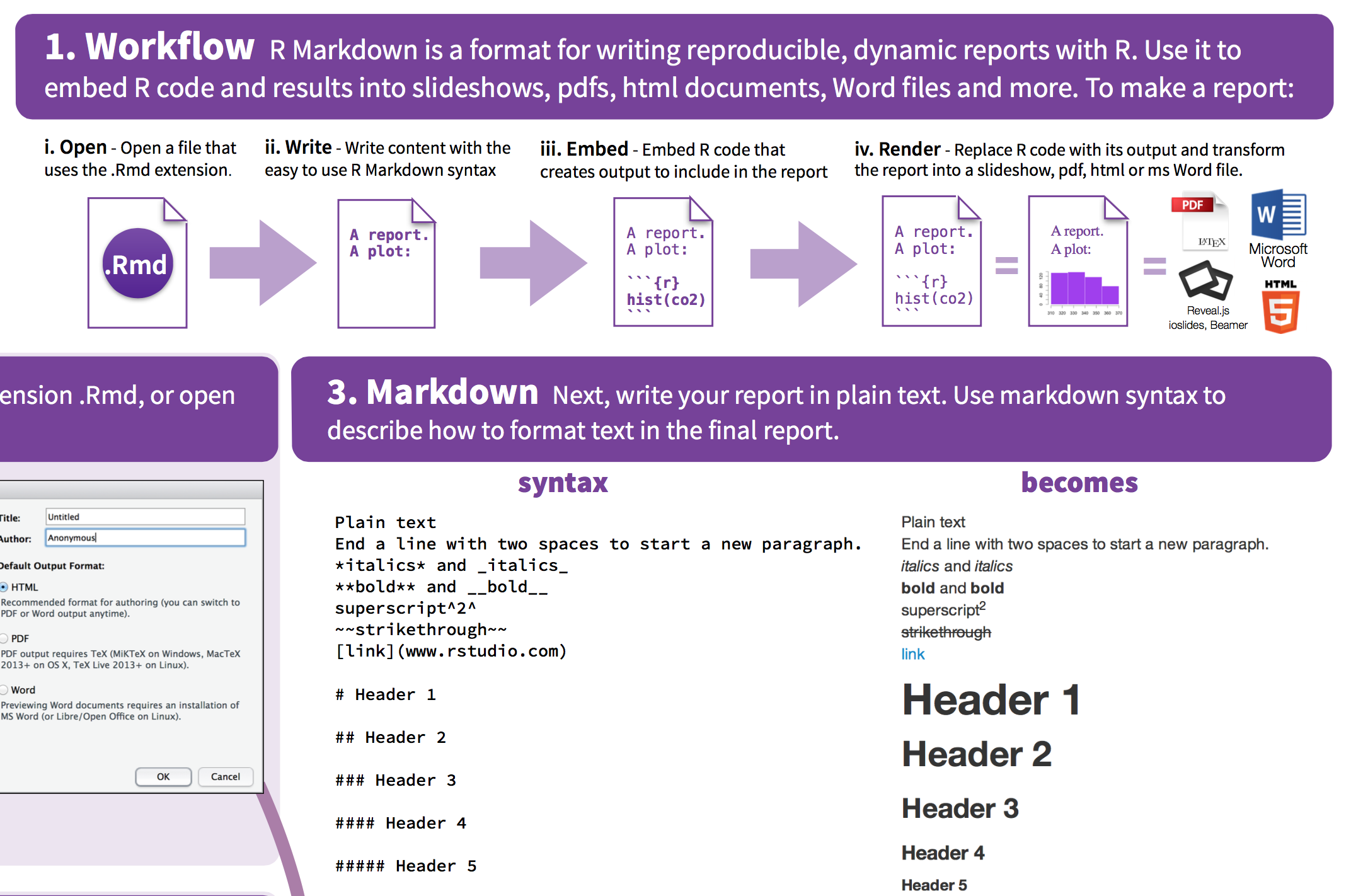R Markdown Cheat Sheet learn more at rmarkdown.rstudio.com rmarkdown 0.2.50 Updated: 8/14 1. Workflow R Markdown is a format for writing reproducible, dynamic reports with R. Use it to embed R code and results into slideshows, pdfs, html documents, Word files and more. To make a report. YAML can be used at the top of Markdown documents to add more structured data. Surround the YAML with two lines of consecutive dashes.- name: 'Venus' discoverer: 'Galileo Galilei' -.Venus. is the second planet from the Sun, orbiting it every 224.7 Earth days. Markdown is a way to style text on the web. You control the display of the document; forma˜ing words as bold or italic, adding images, and creating lists are just a few of the things we can do with Markdown. Mostly, Markdown is just regular text with a few non-alphabetic characters thrown in, like # or.
2.5 Markdown syntax
R Markdown Reference Guide
The text in an R Markdown document is written with the Markdown syntax. Precisely speaking, it is Pandoc’s Markdown. There are many flavors of Markdown invented by different people, and Pandoc’s flavor is the most comprehensive one to our knowledge. You can find the full documentation of Pandoc’s Markdown at https://pandoc.org/MANUAL.html. We strongly recommend that you read this page at least once to know all the possibilities with Pandoc’s Markdown, even if you will not use all of them. This section is adapted from Section 2.1 of Xie (2016), and only covers a small subset of Pandoc’s Markdown syntax.
2.5.1 Inline formatting
Inline text will be italic if surrounded by underscores or asterisks, e.g., _text_ or *text*. Bold text is produced using a pair of double asterisks (**text**). A pair of tildes (~) turn text to a subscript (e.g., H~3~PO~4~ renders H3PO4). A pair of carets (^) produce a superscript (e.g., Cu^2+^ renders Cu2+).
To mark text as inline code, use a pair of backticks, e.g., `code`. To include (n) literal backticks, use at least (n+1) backticks outside, e.g., you can use four backticks to preserve three backtick inside: ```` ```code``` ````, which is rendered as ```code```.
Hyperlinks are created using the syntax [text](link), e.g., [RStudio](https://www.rstudio.com). The syntax for images is similar: just add an exclamation mark, e.g., . Footnotes are put inside the square brackets after a caret ^[], e.g., ^[This is a footnote.].
There are multiple ways to insert citations, and we recommend that you use BibTeX databases, because they work better when the output format is LaTeX/PDF. Section 2.8 of Xie (2016) has explained the details. The key idea is that when you have a BibTeX database (a plain-text file with the conventional filename extension .bib) that contains entries like:
You may add a field named bibliography to the YAML metadata, and set its value to the path of the BibTeX file. Then in Markdown, you may use @R-base (which generates “R Core Team (2021)”) or [@R-base] (which generates “(R Core Team 2021)”) to reference the BibTeX entry. Pandoc will automatically generated a list of references in the end of the document.
2.5.2 Block-level elements
Section headers can be written after a number of pound signs, e.g.,
If you do not want a certain heading to be numbered, you can add {-} or {.unnumbered} after the heading, e.g.,
Unordered list items start with *, -, or +, and you can nest one list within another list by indenting the sub-list, e.g.,
The output is:

- one item
- one item
- one item
- one more item
- one more item
- one more item
Ordered list items start with numbers (you can also nest lists within lists), e.g.,

The output does not look too much different with the Markdown source:
- the first item
- the second item
- the third item
- one unordered item
- one unordered item
Blockquotes are written after >, e.g.,
The actual output (we customized the style for blockquotes in this book):
“I thoroughly disapprove of duels. If a man should challenge me,I would take him kindly and forgivingly by the hand and lead himto a quiet place and kill him.”
— Mark Twain
Plain code blocks can be written after three or more backticks, and you can also indent the blocks by four spaces, e.g.,
In general, you’d better leave at least one empty line between adjacent but different elements, e.g., a header and a paragraph. This is to avoid ambiguity to the Markdown renderer. For example, does “#” indicate a header below?
And does “-” mean a bullet point below?
Different flavors of Markdown may produce different results if there are no blank lines.
2.5.3 Math expressions
Inline LaTeX equations can be written in a pair of dollar signs using the LaTeX syntax, e.g., $f(k) = {n choose k} p^{k} (1-p)^{n-k}$ (actual output: (f(k)={n choose k}p^{k}(1-p)^{n-k})); math expressions of the display style can be written in a pair of double dollar signs, e.g., $$f(k) = {n choose k} p^{k} (1-p)^{n-k}$$, and the output looks like this:
[fleft(kright)=binom{n}{k}p^kleft(1-pright)^{n-k}]
You can also use math environments inside $ $ or $$ $$, e.g.,
[begin{array}{ccc}x_{11} & x_{12} & x_{13}x_{21} & x_{22} & x_{23}end{array}]
[X = begin{bmatrix}1 & x_{1}1 & x_{2}1 & x_{3}end{bmatrix}]
[Theta = begin{pmatrix}alpha & betagamma & deltaend{pmatrix}]
[begin{vmatrix}a & bc & dend{vmatrix}=ad-bc]

| # by(data, factorlist, function) |
| by(pf$friend_count, pf$gender, summary) |
| # Getting logical |
| pf$mobile_check_in<-NA |
| pf$mobile_check_in<- ifelse(pf$mobile_likes>0, 1, 0) |
| percent_mobile<- sum(pf$mobile_check_in)/length(pf$mobile_check_in) *100 |
| # Getting a sample and analyze it |
| set.seed(4231) |
| sample.ids<- sample(levels(yo$id), 16) |
| # Get 16 samples of the yo$id parameter, we're selecting 16 householders that sells |
| ggplot(aes(x=time, y=price), |
| data= subset(yo, id%in%sample.ids)) + |
| facet_wrap(~id) + |
| geom_line() + |
| geom_point(aes(size=all.purchases), pch=1) |
| # Scatterplot Matrix |
| install.packages('GGally') |
| library(GGally) |
| set.seed(1836) # We'll get a sample of 1000 rows within the total |
| pf_subset<-pf[ , c(2:15)] |
| names(pf_subset) |
| ggpairs(pf_subset[sample.int(nrow(pf_subset), 1000), ]) |
| ggpairs(pf_subset[sample.int(nrow(pf_subset), 1000), ], axisLabels='internal') |
Markdown Cheatsheet
